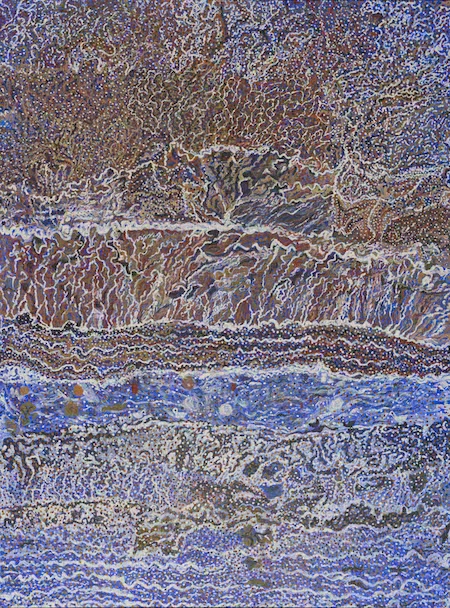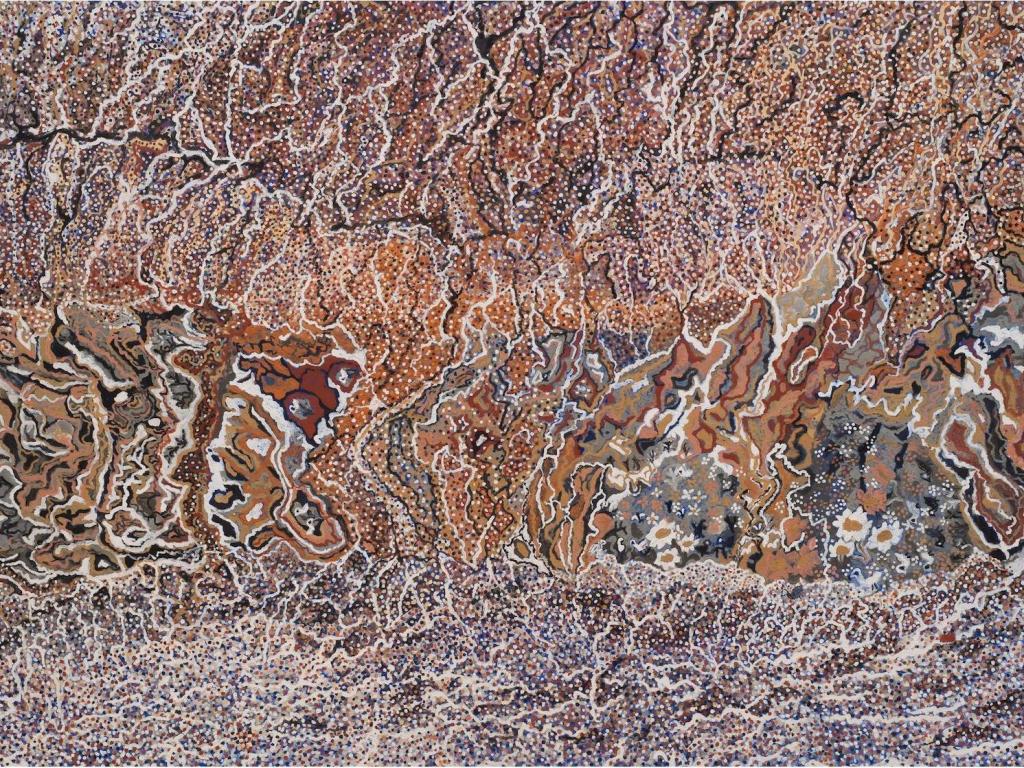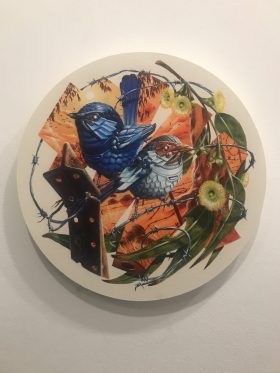Ngak-pungarichan (Clearwater) 2013, Synthetic polymer paint and natural pigments with synthetic polymer binder on canvas / 200 x 290 cm, Purchased 2013. Queensland Art Gallery | Gallery of Modern Art Foundation
One of Australia’s leading Indigenous artists, Mrs Ngallametta, passed away on 28 January. She was 75.
She passed away in her Aurukun home, on Country and surrounded by her family, as she had wished.
Ngallametta was described as ‘one of the fastest-rising talents in the Aboriginal art scene’, and as both ‘a master colourist and an alchemist of sorts’.
In 2013, Ngallametta won the Telstra General Painting Award, and more recently in 2018 she received the Red Ochre Award, the Australia Council’s distinguished Award for Lifetime Achievement.
Fittingly, Ngallametta’s last two paintings were acquired by the Queensland Art Gallery I Gallery of Modern Art, and the National Gallery of Australia.
Ngallametta will be the subject of a major retrospective at the Queensland Art Gallery from 28 March – 23 August 2020.
Director of QAGOMA, Chris Saines told ArtsHub: ‘There could be no greater tribute than to acknowledge that she was a great artist who wrote the story of her country in the colours of her land. She has left us an astonishing legacy. I think this is a big loss for the Australian art world.’
His words were echoed by Franchesca Cubillo, Senior Curator Aboriginal and Torres Strait Islander Art at the National Gallery of Australia: ‘The Gallery has been incredibly fortunate over the years to have worked alongside of her, travelling with her nationally and internationally, hearing her many remarkable stories and songs of Family, History, Country and Culture. With great generosity, openess and joy she inspired and encouraged us with her positive effervescent personality. We will forever be indebted to her for sharing the wonderfully rich and complex aesthetic of her people, the Kugu Uwanh peoples and we particularly pay our respects to her family, friends and community at this difficult this time.’
Saines continued: ‘She was one of those rare artists who rarely missed turning out a great painting every time she picked up a brush … Perhaps she has flown under the radar for a lot for people, but her big works were always immediately drawn into public collections, demonstrating the surety of her hand and the innovative energy inherent to her works.’
Saines gave credit to Ngallametta’s gallerist, Martin Browne, who worked with the artist to ensure her works were placed in important Australian collections.
Mrs Ngallametta was born in the coastal country of the Kugu people around the Kendall River south of Aurukun on the Cape York Peninsula (northern Queensland). She was a senior Elder of the Putch clan and a cultural leader of the Wik and Kugu people of Aurukun.
Like many Indigenous women, she began her career as a weaver, and become known for her dramatic use of natural colours and asymmetrical creations. Taught by senior Wik and Kugu women on country and at the mission school, her early work included mats, baskets and dilly bags made from cabbage palm and pandanus.
In 2009 that she became involved with Ghost Nets Australia, ‘a movement spearheaded by Indigenous communities to bring attention to the plastic fishing nets killing marine life and making landfall on beaches around Northern Australia’.
A year earlier, Ngallametta had turned her hand to painting, encouraged by Gina and Guy Allain, the Wik and Kugu Art Centre Managers. While she started with smaller canvases, it was a challenge from Sydney gallerist Martin Browne in 2011 to make paintings ‘as high as a wall’ that saw her move into the next, significant chapter of her career.
Browne said in a formal statement: ‘It was these vast and astonishingly detailed paintings that forged her reputation as one of Australia’s greatest artists.’
While not feverishly prolific (understandable at her age), she had created in excess of 40 large-scale paintings since 2011, most of which have been acquired by major public and private collections. Her works are held by the National Gallery of Australia, the Art Gallery of NSW, QAGOMA, the Pat Corrigan Collection and Holmes à Court Collection, among others.

Wutan #2 2014, Natural pigments and charcoal with acrylic binder on canvas / 272 x 200 cm, Purchased 2015 with funds from Cathryn Mittelheuser AM through the Queensland Art Gallery | Gallery of Modern Art Foundation
Her work was also included in the major touring exhibition Saltwater Country, organised by the Gold Coast City Gallery, which travelled to Washington DC (USA), the Museum of Contemporary Aboriginal Art in Utrecht (Netherlands), and regionally across Australia.
Ngallametta’s paintings always depicted her Country – the complex river systems, coastline and wetlands of the western side of the Cape York Peninsula around Aurukun – and were ‘distinguished by their multiple perspectives within the one image,’ explained Browne.
He continued: ‘Subtle shifts within her paintings have the viewer flying above the landscape in some sections, while in others they are on the ground, in and amongst her Country, its flowers and animals.’
Sally Butler, of The University of Queensland, cast further light on Ngallametta’s style in The Conversation: ‘Unlike the famed Papunya artists from Central Australia and those from Arnhem Land further north, Ngallametta’s style does not derive from any traditional iconography or symbolism. Ngallametta’s work is more in the spirit of artists from Western Australia’s Balgo region … These non-iconographic innovations in visual expression make significant headway in disabling stereotypes about Aboriginal people as being creatively restricted by cultural ritual.’
What further set Ngallametta’s work apart was that she collected and prepared her own ochres from the landscape for her paintings. Saines added: ‘She had this set of amazing repositories and then use that colour to inscribe stories of country in her work.’
At the opening of the gallery’s exhibition GOMA Q (2015), Ngalalametta’s work was presented where visitors first entered the gallery, though Saines noted that her presence went well beyond her work: ‘It was not just the very powerful presence of her work, but the wonderful way she mounted the rostrum, grabbed the microphone and broke into song – song from her Country.’
Browne concluded by quoting the words of Guy Allain, co-manager of the artist, as published in the catalogue of Tarnanthi, Festival of Contemporary Aboriginal and Torres Strait Islander Art, 2015: ‘Fluent in her own traditional languages, she managed through her art to communicate her understanding of Country, reaching across cultures to an ever-wider national and international audience,’ adding that she had a unique ‘painterly voice that joins an ancestral past with the present, stretching boundaries and blurring the distinction between abstraction, art brut, landscape art and story-telling.’
Ngallametta leaves behind a stunning cultural legacy that reminds us to respect the environment and to listen to its lessons.





